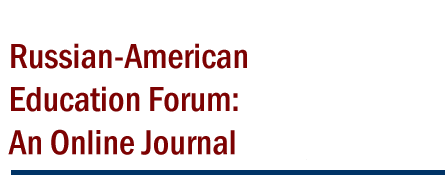

Volume:5, Issue: 1/2
May. 1, 2013


May. 1, 2013
Dear friends and colleagues, new and old readers of our journal:
I am happy to greet you in 2013 and to inform you that due to a number of circumstances we made a decision to combine the first and the second issues. So you are cordially introduced to this united 1-2 issue in Volume 5. For the first time in the journal’s history we directly address the field of comparative education and the research completed by Russian and foreign scholars. By the way, I intentionally use the word “foreign” – you will meet with not only traditionally represented Russian and American researchers but also learn from our colleagues in China, Moldova, Norway, and Uganda.
No doubt, you will find it fascinating to read papers from these countries, different in their approaches, problems and styles, and you will learn how and to what degree the language of instruction, for ex., makes an influence on the intellectual and personality development of children in Tanzania (see: Zehlia Babaci-Wilhite from the University of Oslo, Norway). To a certain extent, this paper corresponds with the article from Dr. Valeev, Kazan Federal University, Tatarstan, who is analyzing the situation with bilingual teaching in the schools of this Russian Volga republic. A different but no less interesting approach you will find in the paper presented by a young doctoral student at Seattle Pacific University and a former teacher from China Daihong Chen who compared the images of Chinese and American instructors and how they are perceived by Chinese students who have both, Chinese and American learning experience. I am sure our Russian readers will find a number of meaningful analogies. The topic of Africa is once again raised by American teacher and researcher Patti Hayes who examines similarities and differences in education in modern United States and post-apartheid South Africa.
And once more, about Africa, but this time about school and teacher preparation and training, and also successful attempts of starting a fruitful cooperation between Sam Houston State University (Texas) and Gulu Core Primary Teachers’ College you will learn from Texas Professors William D. Edgington and James W. Hynes, and Uganda educator, Mr. Denis C. Akwar.
Another innovation in our journal. For the first time ever we are happy to greet an academic and a research administrator of such level – President of the Academy of Sciences of Moldova. A famous scholar, professor Duca, together with his young colleague Diana Stah present a very interesting article about the success and challenges which Moldovan scholars experience trying to integrate into the European Education and Research Space.
And finally… history and history of education as usual. But this time it is represented in a more detailed and diverse way. We are happy to acknowledge the second and again interesting article of a young high school teacher and a WA researcher Eric Boyer who discusses a very challenging topic for Russian educators – how to teach history at high school level and what role it plays in the formation of the next generations.
And the very last but not least, of course, – two equally intriguing and stimulating articles written by already known authors – Professors Mikhail Boguslavsky and Rosa Valeeva who talk about two “educational giants.” Sergei Gessen who has practically reconstructed the Russian education theory after his “rebirth” in post-perestroika Russia some twenty years ago (Boguslavsky’s article) and Kayum Nasari, a talented Tatar educator and reformer who is still hardly known to the wider public. So, don’t miss them.
That’s about it. Let me finish here and invite you to start reading the journal. As usual, we look forward to receiving your opinions and critical comments.
Always yours,
Tatyana Tsyrlina-Spady
Editor-in-Chief
tsyrlina@aol.com
Home | Copyright © 2025, Russian-American Education Forum